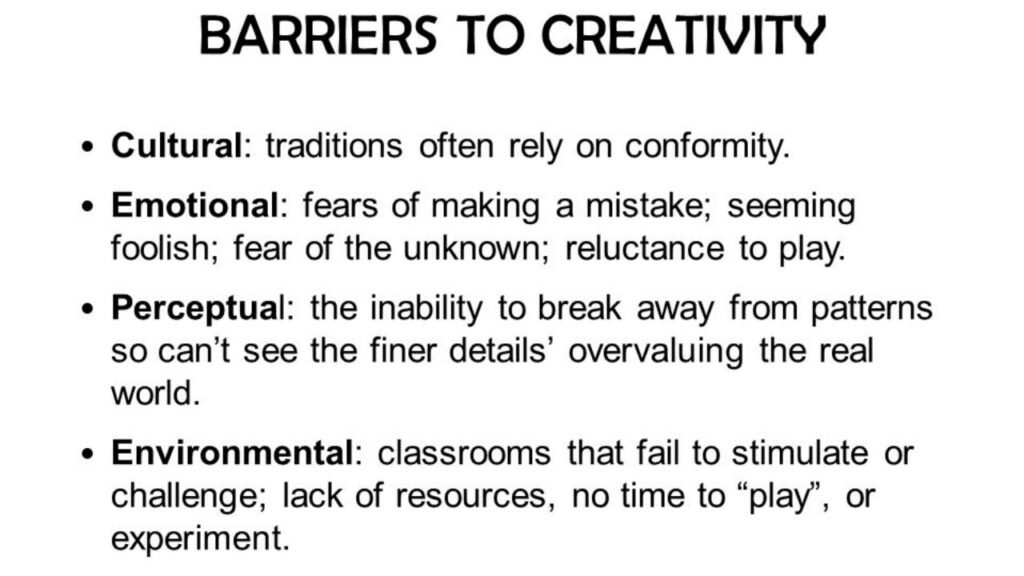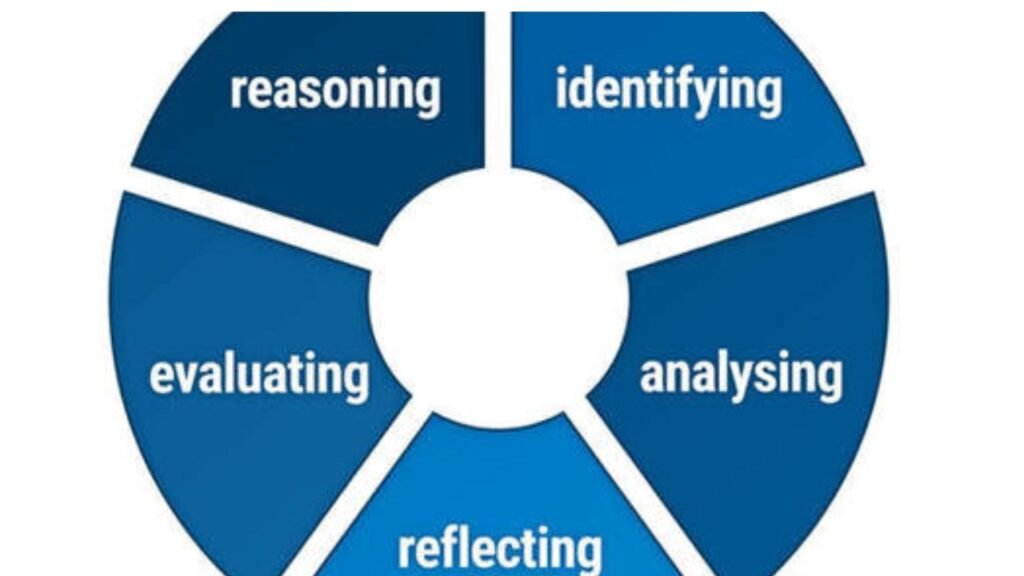Barriers to creative thinking in Class 12 include a lack of confidence, fear of failure, fixed mindset, and external influences. Students often struggle to express their ideas due to self-doubt and societal pressures. Overcoming these barriers requires building confidence, embracing failure as a learning opportunity, cultivating a growth mindset, and creating a supportive environment that encourages exploration and innovation.

Barriers to Creative Thinking in Class 12
Barriers to Creative thinking in class 12 are a fundamental aspect of education, particularly at the class 12 level. It involves generating innovative ideas, exploring different perspectives, and solving complex problems uniquely. However, despite its significance, students often encounter barriers that hinder their ability to think creatively. This article will explore some common obstacles to creative thinking in class 12 and strategies to overcome them.
Lack of Confidence
One of the primary barriers to creative thinking is a need for more confidence. Many students doubt their abilities and hesitate to express their ideas, fearing being judged or criticized. This lack of confidence can stifle creativity and prevent students from exploring unconventional solutions.
This lack of confidence can manifest in various ways, such as reluctance to participate in class discussions, avoidance of challenging tasks, and hesitation to take risks. Overcoming this barrier involves building self-esteem, fostering a supportive environment, and encouraging students to trust their creative capabilities.
Fear of Failure
The fear of failure is another major obstacle to creative thinking. Students may avoid taking risks and experimenting with new ideas because they fear making mistakes or falling short of expectations. This fear can inhibit creativity and limit students’ willingness to explore innovative solutions.
Moreover, this fear of failure can lead to a mindset of perfectionism, where students prioritize avoiding mistakes over pursuing creative solutions. Overcoming this barrier involves reframing failure as a natural part of the learning process and encouraging students to embrace challenges and learn from setbacks.
Fixed Mindset
A fixed mindset, characterized by the belief that abilities are innate and cannot be developed, can impede creative thinking. Students with a fixed mindset may view challenges as threats rather than growth opportunities. This rigid mindset can prevent them from embracing new ideas and learning from setbacks.
Students with a fixed mindset may perceive their intelligence and creativity as fixed traits, leading them to avoid activities that might challenge these beliefs. They may resist trying new approaches or seeking feedback, fearing failure will confirm their limitations. Overcoming this barrier involves promoting a growth mindset, where students understand that abilities can be developed through effort and perseverance.
External Influences
External influences, such as societal norms, peer pressure, and parental expectations, can also hinder creative thinking. Students may feel pressured to conform to conventional thinking patterns and may be reluctant to explore alternative perspectives or challenge existing norms.
These external influences can create a conformist mindset, where students prioritize fitting in and meeting external expectations over expressing their individuality and exploring creative ideas. Peer pressure and societal norms may discourage risk-taking and experimentation, limiting students’ creative freedom. Overcoming this barrier involves fostering an environment that encourages diversity of thought and values creativity as a means of problem-solving and self-expression.

Overcoming Barriers of What are the Barriers to Creative Thinking? Class 12
While the barriers to creative thinking in class 12 seem daunting, several strategies can help students overcome them and unleash their creative potential.
Building Confidence
Building confidence is essential for fostering creative thinking. Students can boost their confidence by acknowledging their strengths, setting realistic goals, and celebrating their achievements, no matter how small.
Moreover, providing opportunities for students to succeed in small tasks and gradually increase the complexity of challenges can help build their confidence incrementally. Encouraging a growth mindset, where mistakes are viewed as opportunities for growth rather than signs of incompetence, also bolsters students’ confidence in their creative abilities.
Embracing Failure
Failure is an inevitable part of the creative process and should be embraced as a learning opportunity rather than feared. Encouraging students to view failure as a stepping stone to success can help them develop resilience and perseverance in facing challenges.
Furthermore, embracing failure fosters a mindset where students are more willing to take risks and explore unconventional ideas, knowing that setbacks are not permanent barriers to success but rather valuable lessons along the way. By reframing failure as a natural and necessary part of the learning journey, students can cultivate resilience and develop the confidence to push the boundaries of their creativity.
Cultivating a Growth Mindset
Cultivating a growth mindset, characterized by the belief that abilities can be developed through effort and perseverance, is crucial for promoting creative thinking. Students with a growth mindset are more likely to embrace challenges, persist in the face of setbacks, and see failure as a temporary setback rather than a reflection of their abilities.
So, cultivating a growth mindset involves:
- Teaching students about the neuroplasticity of the brain.
- Emphasizing the importance of learning from mistakes.
- Providing opportunities for reflection and growth.
By fostering a growth mindset, educators empower students to approach challenges with resilience and optimism, fueling their creativity and innovation.
Limiting External Influences
To foster creative thinking, it’s important to create a supportive environment that encourages students to think independently and express their ideas freely. Limiting external influences that may stifle creativity, such as overly prescriptive assignments or rigid grading criteria, can help students feel more confident exploring innovative solutions.
Additionally, educators can encourage students to question societal norms and challenge conventional thinking by exposing them to diverse perspectives and encouraging critical thinking. Educators can empower students to unleash their full creative potential and thrive as innovative thinkers by creating a classroom culture that values autonomy, creativity, and intellectual curiosity.
Strategies for Enhancing Creative Thinking on What Are the Barriers to Creative Thinking Class 12
In addition to overcoming barriers, students can use several strategies to enhance their creative thinking skills
Encouraging Curiosity
Encouraging curiosity is essential for fostering creative thinking. Teachers can spark students’ curiosity by posing thought-provoking questions, encouraging them to explore topics that interest them, and providing opportunities for hands-on exploration and experimentation.
Furthermore, teachers can create an environment where curiosity is celebrated and inquiry-based learning is encouraged. By fostering a sense of wonder and exploration, educators can ignite students’ passion for learning and inspire them to approach problems creatively and open-mindedly.
Practicing Divergent Thinking
Divergent thinking, which involves generating multiple solutions to a problem, is a key component of creative thinking. Teachers can encourage divergent thinking by presenting open-ended problems, brainstorming sessions, and encouraging students to explore unconventional ideas and perspectives.
Incorporating activities such as mind mapping, role-playing, and creative writing exercises can help students develop their divergent thinking skills. Teachers empower students to think outside the box and generate original ideas by fostering an environment that values creativity and innovation.
Engaging in Mindfulness Activities
Mindfulness activities, such as meditation, yoga, and deep breathing exercises, can help students quiet their minds, reduce stress, and enhance their focus and creativity. Integrating mindfulness practices into the classroom can create a conducive environment for creative thinking and problem-solving.
Furthermore, mindfulness activities promote self-awareness and emotional regulation, enabling students to approach challenges with clarity and resilience. By incorporating mindfulness into daily routines, educators support students’ well-being while nurturing their creative potential.
Collaborating with Peers
Collaborating with peers can stimulate creative thinking by exposing students to different perspectives and ideas. Group projects, brainstorming sessions, and collaborative problem-solving activities can encourage students to share their ideas, build on each other’s strengths, and generate innovative solutions.
Additionally, peer collaboration fosters communication and teamwork skills, preparing students for real-world collaborative environments. By working together, students learn to value diverse viewpoints and leverage collective intelligence to tackle complex problems creatively.
Integrating Creative Thinking in Education About What are the Barriers to Creative Thinking Class 12
Integrating creative thinking into education requires a concerted effort from educators, policymakers, and parents.
Incorporating Creative Assignments
Incorporating creative assignments, such as project-based learning, design challenges, and artistic expressions, can allow students to apply their creative thinking skills in real-world contexts.
Moreover, creative assignments promote student engagement and autonomy, allowing students to explore topics of personal interest and express their creativity in diverse ways. Creative assignments deepen students’ understanding and appreciation for the subject by bridging classroom learning with real-world applications.
Encouraging Exploration and Experimentation
Encouraging exploration and experimentation is essential for fostering creative thinking. Teachers can create a supportive environment encouraging students to take risks, explore new ideas, and learn from mistakes.
Furthermore, providing opportunities for hands-on learning and inquiry-based activities encourages students to think critically and problem-solve independently. By embracing a culture of exploration and experimentation, educators empower students to become confident and innovative thinkers.
Fostering a Supportive Environment
Fostering a supportive environment is crucial for promoting creative thinking. Teachers can create a classroom culture that celebrates diversity, encourages risk-taking, and values creativity and innovation.
However, fostering a supportive environment involves nurturing a sense of belonging and acceptance among students, who feel comfortable expressing their ideas without fear of judgment. By fostering positive relationships and providing constructive feedback, educators create a safe space for students to explore their creativity and push the boundaries of their thinking.
Conclusion
Creative thinking is a vital skill that students need to succeed in class 12 and beyond. By identifying and overcoming barriers to creative thinking and implementing strategies to enhance it, educators can empower students to become innovative problem solvers and critical thinkers. Ultimately, fostering a culture of creativity in the classroom prepares students for academic success and equips them with the essential skills needed to thrive in an ever-evolving global landscape.
FAQs
Why is Creative Thinking Important in Class 12 Education?
Creative thinking is important in class 12 education because it helps students develop critical thinking skills, problem-solving abilities, and innovative thinking, essential for success in higher education and the workforce.
How Can Teachers Promote That? What are the Barriers to Creative Thinking in Class 12 in the Classroom?
Teachers can promote creative thinking in the classroom by creating a supportive environment, encouraging curiosity and exploration, providing opportunities for collaboration and experimentation, and incorporating creative assignments and activities into their lessons.
What are Some Common Barriers to That What are the Barriers to Creative Thinking Class 12 in the Classroom?
Some common barriers to creative thinking include lack of confidence, fear of failure, fixed mindset, and external influences such as societal norms and peer pressure.
How Can Students Overcome the Fear of Failure?
Students can overcome the fear of failure by reframing failure as a learning opportunity, setting realistic goals, celebrating their achievements, and cultivating a growth mindset that embraces challenges and sees failure as a natural part of the learning process.
How Can Parents Support Creative Thinking Development at Home That the Barriers to Creative Thinking Class 12 in the Classroom?
Parents can support creative thinking at home by encouraging curiosity, providing opportunities for open-ended exploration, and fostering a growth mindset. By creating a supportive environment that values creativity and resilience, parents can help their children overcome barriers to creative thinking encountered in the classroom.


